Paleoflora of the Eocene Okanagan Highlands
The paleoflora of the Eocene Okanagan Highlands includes all plant and fungi fossils preserved in the Eocene Okanagan Highlands Lagerstätten. The highlands are a series of Early Eocene geological formations which span an 1,000 km (620 mi) transect of British Columbia, Canada and Washington state, United States and are known for the diverse and detailed plant fossils which represent an upland temperate ecosystem immediately after the Paleocene-Eocene thermal maximum, and before the increased cooling of the middle and late Eocene to Oligocene. The fossiliferous deposits of the region were noted as early as 1873, with small amounts of systematic work happening in the 1880-90s on British Columbian sites, and 1920-30s for Washington sites. A returned focus and more detailed descriptive work on the Okanagan Highlands sites revived in the 1970's. The noted richness of agricultural plant families in Republic and Princeton floras resulted in the term "Eocene orchards" being used for the paleofloras.
Paleoflora
The Eocene Okanagan Highlands hosted a diverse mix of temperate and tropical paleobiotic elements,[1] with the forests having the first significant proportions of temperate plants in North America.[2] The paleobotanical community was a mixture of plants found in subtropical evergreen and temperate deciduous forests.[1] Included in the forest were a number of important modern temperate flowering plant families such as Betulaceae, Rosaceae, and Sapindaceae, plus the conifer family Pinaceae. Study of the deciduous plants from the highlands has documented the occurrence of heteromorphic leaves derived from sun versus shade conditions and long shoot or short shoot buds.[2] The paleobotanical community of the Republic area has been noted as the most diverse floral community of the Okanagan highlands, with some estimates ranging to over 68 families and 134 genera being present.[3] The noted richness of Rosaceae fossils along with other important agricultural plant families found in the Republic and Princeton floras, including the genera that contain modern apples, blackberries, cherries, and serviceberries resulted in Wes Wher and Donald Hopkins (1994) coining the term "Eocene orchards".[4][5] Fossil evidence from both Sorbus/Crataegus and Rhus leaves in the Republic sites indicate the area was a center for species overlap and active hybridization events.[2]
Extent
The majority of the lake deposits are compression fossils in lake bed sediments grouped informally into "Northern", "Central", and "Southern" sites.[6] The Northern sites are comprised of unnamed Ootsa Group formations which outcrop as the "Driftwood shales" near Smithers, British Columbia, sites now considered lost in the Quesnel, British Columbia area,[7] and the "Horsefly shales", of an unnamed formation and unnamed group which outcrop around Horsefly, British Columbia.[6] The Central sites represent Kamloops Group formations with the McAbee Fossil Beds, Tranquille River site and Falkland site, all in the Tranquille Formation, the Quichena site and Stump Lake site in the Coldwater Beds and outcrops of the Chu Chua Formation near Barriere, British Columbia. The Southern sites include the Princeton Group Allenby Formation sites surrounding Princeton, British Columbia, such as "Nine Mile Creek", "One Mile Creek", "Pleasant Valley", "Thomas Ranch", "Vermilian Bluffs", and "Whipsaw Creek". The most southerly of the Okanagan Highlands lakes, the Klondike Mountain Formation in Northern Ferry County, Washington include the "Boot Hill", "Corner Lot", "Gold Mountain", "Knob Hill", and "Mount Elizabeth" localities.[6] Closely correlated with the Klondike Mountain Formation are the Penticton groups Kettle River, Marama and Marron Formations in the Boundary District along the Canada-United States border.[8]
There is debate as to the affiliation of the, now lost, Quesnel outcrops with the Greater Okanagan Highlands. Archibald et al (2018) in the monograph overview of the Highlands Hymenoptera included them as part of the series. However the certainty for the placement was later questioned by Archibald and Cannings (2022) who opted to tentatively exclude Quesnel from the highlands while discussing the history of field collecting in the region.[7]
Chert and amber

Additionally two important non-compression biotas are present in the Eocene Okanagan Highlands. A permineralized chert flora, the Princeton Chert is found along the Similkameen River interbedded with coal deposits of the Ashnola shale unit, Allenby Formation known for anatomically preserved plants.[9] In the Central sites, subbituminous coal of the Hat Creek Coal Formation around Hat Creek hosts an amber fauna, the Hat Creek amber which preserves many small insects that would likely not be found in the compression biotas.[10]
Diatoms
Two algae taxa of the protist order Ochrophyta have been described from the highlands, and are placed in the family Aulacoseiraceae, a member of the diatom order Bacillariophyceae,.[11] The third algae is identified as a living paleoendemic Mallomonas species now restricted to warmer climates in North America and Europe.[12]
| Family | Genus | species | Sites | Notes | Images |
|---|---|---|---|---|---|
|
"Undescribed"[11] |
|
An aulacoseiraceous diatom |
|||
|
|||||
|
An mallomonadaceous synurid algae |
Bryophytes
A group of six mosses were described from the Allenby Formation by Kuc (1972,1974) representing the genera Ditrichites, Hypnites and Plagiopodopsis, with two species placed in the morphogenus Muscites.[14][15] Further revision of the fossils was conducted by Milner (1980), who placed two species into the genus Plagiopodopsis and moved both species described as Palaeohypnum to other genera.[16] One further moss has been described from Horsefly, and placed in the living genus Aulacomnium by Janssens et al (1979).[17] Dillhoff et al. (2013) reference undescribed moss specimens from the Klondike Mountain Formation known from vegetative gametophytes.[18]
| Family | Genus | species | Sites | Notes | Images |
|---|---|---|---|---|---|
|
|||||
|
|||||
|
An amblystegiaceous moss, |
||||
|
An amblystegiaceous moss |
||||
|
A bartramiaceous moss |
||||
|
Incertae sedis |
|
A moss of uncertain placement |
|||
|
Incertae sedis |
|
A moss of uncertain placement |
|||
|
Undescribed |
Undescribed |
Undescribed[18] |
|
Undescribed moss specimens |
 |
Lycophytes
Both an undescribed member of the fossil quillwort genus Isoetites[19] and the spikemoss genus Selaginella[20] have been found in the Klondike Mountain Formation, while an additional fossil deemed Cf. Selaginella was later reported from the Allenby Formation.[18]
| Family | Genus | species | Sites | Notes | Images |
|---|---|---|---|---|---|
|
Undescribed[19] |
|
A quillwort relative |
 | ||
|
Undescribed[20] |
|
A spikemoss |
 | ||
|
Undescribed[18] |
|
A spikemoss from the Thomas Ranch site. |
Pteridophytes
Four species of ferns and fern relatives have been described from the compression biotas and an additional four compression taxa that have been tentatively identified to family or genus. A series of four additional ferns have been described from premineralized specimens in the Princeton Chert and a fifth taxon is identified to genus.
| Family | Genus | species | Sites | Notes | Images |
|---|---|---|---|---|---|
|
|||||
|
|||||
|
A blechnacious fern |
||||
|
|||||
|
Undescribed[20] |
|
A possible bladder fern relative. |
|||
|
 | ||||
|
|||||
|
A scouring rush |
 | |||
|
A scouring rush. |
 Not described | |||
|
|||||
|
Undescribed[20] |
|
A climbing fern. |
|||
|
An osmundaceous fern |
||||
|
A mosquito fern, |
 | |||
|
A mosquito fern, |
||||
|
Undescribed[23] |
|
A "watermoss" species. |
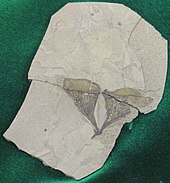 not described |
Gymnosperms
Three major groups of gymnosperms are present in the Okanagan Highlands formations, with the most speciose being the pinophytes. The ginkgophytes are represented by two species of Ginkgo, while an undescribed Zamiaceae member is the sole cycadophyte.
Cycadophytes
| Name | Authority | Year | Family | Notes | Images |
|---|---|---|---|---|---|
|
Undescribed |
|
A zamiaceous cycad. |
 |
Gingkophytes
| Name | Authority | Year | Family | Notes | Images |
|---|---|---|---|---|---|
|
A ginkgo, |
 | |||
|
A ginkgo |
 | |||
|
A ginkgo |
Conifers
Cupressaceae
| Name | Authority | Year | Subfamily | Notes | Images |
|---|---|---|---|---|---|
|
Undescribed[36] |
|
A Cunninghamia |
 | ||
|
An incense cedar |
||||
|
|||||
|
A false cypress |
||||
|
Undescribed[31] |
|
A juniper |
|||
|
An arborvitae |
||||
|
Undescribed[36] |
|
An incense cedar relative |
|||
|
Undescribed[36] |
|
A Hiba relative |
|||
|
|||||
|
A dawn redwood |
 | |||
|
Undescribed[34] |
|
A dawn redwood |
|||
|
A Redwood |
 | |||
|
|||||
|
Undescribed[23] |
|
A Taiwania species |
|||
|
A sugi |
||||
|
|||||
|
A Chinese swamp cypress |
 | |||
|
|||||
|
A bald cypress |
Pinaceae
| Name | Authority | Year | Subfamily | Notes | Images |
|---|---|---|---|---|---|
|
Oldest true fir described |
 | |||
|
A fir conescale morphospecies |
||||
|
A true fir |
||||
|
Undescribed[34] |
|
A Keteleeria species |
|||
|
A golden larch |
||||
|
A long bracted golden larch |
 | |||
|
A golden larch |
||||
|
A hemlock |
||||
|
A Carbonized/petrified wood species |
||||
|
A spruce cone species |
 | |||
|
A spruce |
||||
|
A 2-needled Pine |
||||
|
A 3-needled Pine |
||||
|
A basal Pine, |
||||
|
A permineralized pinaceous wood, compression cone species |
 | |||
|
A permineralized pinaceous cone |
||||
|
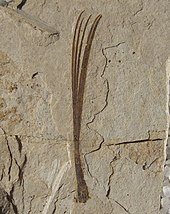 | ||||
|
A 3 needle pine, jr homoym to Pinus macrophylla Lindley 1839 |
 | |||
|
A pinaceous winged seed morphogenus |
 | |||
|
A pinaceous cone |
||||
|
A basal Pine, |
||||
|
A possible 4 needled pine |
 | |||
|
|||||
|
|||||
|
A pine |
Sciadopityaceae
| Name | Authority | Year | Family | Notes | Images |
|---|---|---|---|---|---|
|
Undescribed[40] |
|
An umbrella pine species |
 |
Taxaceae
| Name | Authority | Year | Family | Notes | Images |
|---|---|---|---|---|---|
|
A yew |
 | |||
|
A yew |
||||
|
A yew |
||||
|
Undescribed[31] |
|
A plum-yew |
|||
|
A yew |
||||
|
Undescribed[31] |
|
A yew |
|||
|
A plum-yew relative |
Angiosperms
Nymphaeales
The basal angiosperms are represented by two Nymphaeales water-lily species Nuphar carlquistii[58] from the Republic and Princeton shales, plus Allenbya collinsonae from the Princeton Chert.[59] Wehr (1995) illustrated two fossils that were tentatively identified as fruits of the banana genus Ensete and the extinct myrtle genus Paleomyrtinaea respectively,[60] however further fossil finds resulted in the re-identification of the first as a N. carlquistii rhizome section, and the second is a seed mass from the same water-lily.[58]
| Order | Genus | species | Sites | Notes | Images |
|---|---|---|---|---|---|
|
A waterlily relative. |
||||
|
A waterlily, |
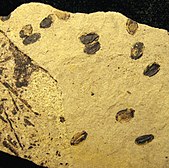 |
Magnoliids
| Family | Genus | species | Sites | Notes | Images |
|---|---|---|---|---|---|
|
Undescribed[31] |
|
A spicewood species. |
|||
|
Undescribed[20] |
|
A lauraceous form species. |
|||
|
Undescribed[20] |
|
A stinkwood species. |
|||
|
A Phoebe sp. |
||||
|
A sassafras |
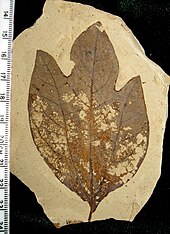 | |||
|
A sassafras species |
||||
|
A Liriodendron-like wood. |
||||
|
Undescribed[4] |
|
A magnolia, possibly Magnolia subgenus Talauma |
 | ||
|
A lizard's-tail species |
||||
|
A flower of uncertain floral relationship, possibly of Magnoliid affinity |
 | |||
|
A possibly aquatic magnoliopsid |
Monocots
| Family | Genus | species | Sites | Notes | Images |
|---|---|---|---|---|---|
|
An aquatic or emergent water-plantain |
||||
|
An onion relative |
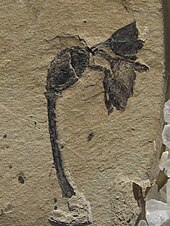 | |||
|
Grímsson, Zetter, & Halbritter |
A Cape-pondweed pollen |
||||
|
An arum family member |
||||
|
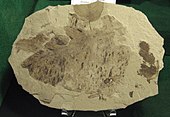 | ||||
|
|||||
|
Undescribed[20] |
|
A greenbrier species. |
|||
|
A cattail species. |
||||
|
A possible iridaceous pollen morphotype |
||||
|
Incertae sedis |
|
A cyperaceous or juncaceous poalean monocot |
|||
|
Incertae sedis |
|
A lilialean genus of uncertain placement |
Eudicots
"Basal eudicots"
| Family | Genus | species | Sites | Notes | Images |
|---|---|---|---|---|---|
|
Undescribed[60] |
|
A moonseed |
|||
|
A plane tree relative fruiting head. |
||||
|
A plane tree relative. |
 | |||
|
Undescribed[76] |
|
A plane tree fruit taxon |
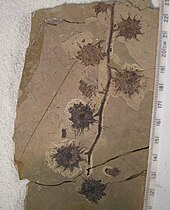 | ||
|
A plane tree relative |
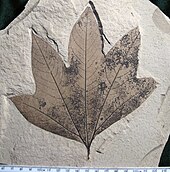 | |||
|
A sycamore relative |
||||
|
Undescribed[77] |
|
A sycamore stamen head |
|||
|
A Clematis |
 | |||
|
Undescribed[60] |
|
A Meliosma species |
|||
|
Undescribed[60] |
|
A Sabia species |
|||
|
Undescribed[20] |
|
A kadsura species. |
|||
|
A trochodendroid of uncertain placement.[78] |
||||
|
A Trochodendrale |
||||
|
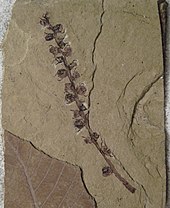 | ||||
|
A Trochodendrale, |
 | |||
|
A Trochodendron |
||||
|
Pigg, Wehr, & Ickert-Bond |
A Trochodendron |
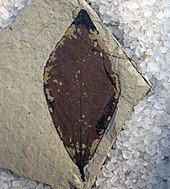 | |||
|
A trochodendroid of uncertain placement.[78] |
 |
"Superasterids"
| Family | Genus | species | Sites | Notes | Images |
|---|---|---|---|---|---|
|
Undescribed[31] |
|
A holly |
|||
|
Undescribed[36] |
|
A spikenard species |
|||
|
Undescribed[36] |
|
A spikenard species foliage |
|||
|
Undescribed[36] |
|
A spikenard species fruit |
|||
|
Undescribed |
Undescribed[76] |
|
A catalpa family member |
 | |
|
A dogwood species, |
||||
|
unidentifed |
|
A punitive persimmon relative. |
|||
|
A madrone relative |
||||
|
A Rhododendron |
||||
|
Undescribed[4] |
|
A doghobble relative |
|||
|
A Rhododendron |
||||
|
A "hard rubber tree" fruit |
 | |||
|
A "hard rubber tree" leaf |
||||
|
Undescribed[4] |
|
A Hydrangea. |
|||
|
Undescribed[4] |
|
A mock-orange |
|||
|
A Phytocrene relative |
||||
|
A tuplo relative. |
||||
|
A dove-tree relative |
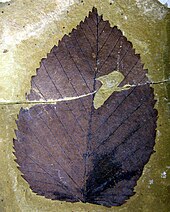 | |||
|
An ash species with notched samara apex. |
||||
|
An ash species with rounded samara apex. |
||||
|
undescribed[31] |
|
A possible ash relative. |
|||
|
A possible Schoepfia relative, |
 | |||
|
"Species A"[45] |
|
A theaceous species similar to Gordonia |
|||
|
"Species B"[45] |
|
A theaceous species similar to Cleyera |
"Superrosids"
| Family | Genus | species | Sites | Notes | Images |
|---|---|---|---|---|---|
|
A sumac |
 | |||
|
A sumac with leaflets on short petiolules |
 | |||
|
A sumac with leaflets on short petiolules |
 | |||
|
A sumac with sessile leaflets |
||||
|
Undescribed[31] |
|
A sumac species |
|||
|
An alder. |
||||
|
An alder. |
||||
|
An alder. |
||||
|
An alder. |
 | |||
|
An alder species |
||||
|
An birch species |
 | |||
|
An birch species |
||||
|
A hornbeam |
 | |||
|
 | ||||
|
Undescribed[31] |
|
A hazel nut relative |
|||
|
An extinct coryloid relative |
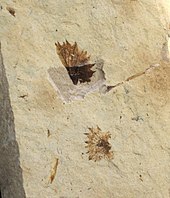 | |||
|
An extinct coryloid relative. |
||||
|
An extinct coryloid relative |
||||
|
A Palaeocarpinus species |
 | |||
|
A hazel nut |
||||
|
Undescribed |
Undescribed[31] |
|
A betulaceous taxon |
||
|
An extinct Bursera relative |
 | |||
|
Undescribed[77] |
|
A cannabaceous fruit |
 | ||
|
A katsura leaf morphotype |
||||
|
A katsura with suggested affinity to †Joffrea,[36] |
 | |||
|
Unidentified |
Unidentified[45] |
|
A katsura relative with suggested affinity to †Joffrea or †Nyssydium[36] |
 | |
|
Undescribed[77] |
|
An elaeocarpaceous fruit |
 | ||
|
undescribed[31] |
|
An fagaceous morphogenus |
|||
|
An extinct beech relative |
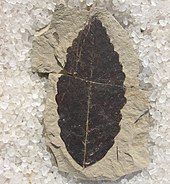 | |||
|
undescribed |
|
An extinct beech relative |
|||
|
A beech |
 | |||
|
Undescribed[36] |
|
A beech |
|||
|
An oak leaf species |
||||
|
An oak |
||||
|
undescribed[31] |
|
An fagaceous morphogenus |
|||
|
Undescribed[91] |
|
A current fruit |
|||
|
A current |
||||
|
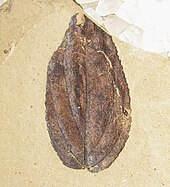 | ||||
|
Undescribed[31] |
|
A winter-hazel |
|||
|
 | ||||
|
A virginia willow species |
||||
|
A punitive hickory |
||||
|
A punitive hickory |
||||
|
Undescribed[23] |
|
A possible hickory |
|||
|
A walnut family relative. |
||||
|
A walnut family relative. |
||||
|
A wingnut relative. |
||||
|
|||||
|
Undescribed[36] |
|
A swamp loosestrife |
|||
|
Undescribed[76] |
|
A Craigia species |
 | ||
|
A Florissantia species |
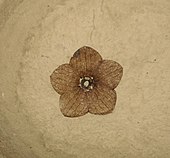 | |||
|
Undescribed[23] |
|
A Florissantia species |
|||
|
Undescribed[4] |
|
A hibiscus |
|||
|
Undescribed[76] |
|
A linden relative |
|||
|
A Linden |
 | |||
|
A Linden relative |
 | |||
|
Undescribed[4] |
|
A mulberry, two types known. |
|||
|
A comptonia species |
 | |||
|
A comptonia species | ||||
|
A comptonia species |
||||
|
A bayberry species |
||||
|
A Myrtaceous fruit |
||||
|
A milkwort relative |
 | |||
|
Undescribed[4] |
|
A service berry |
|||
|
|||||
|
Undescribed[4] |
|
A snow-wreath |
|||
|
An Osoberry |
||||
|
A rose family flower |
||||
|
A Christmas-berry relative |
 | |||
|
Undescribed[31] |
|
A Christmas-berry relative |
|||
|
A prunoid wood. |
||||
|
A cherry relative |
 | |||
|
"Princeton chert species 1"[101] |
|
A prunoid seed. |
|||
|
"Princeton chert species 2"[101] |
|
A prunoid seed. |
|||
|
"Princeton chert species 3"[101] |
|
A prunoid seed. |
|||
|
"Republic species 1"[45] |
|
A prunoid leaf. |
|||
|
"Republic species 2"[45] |
|
A prunoid leaf. |
|||
|
"Republic species 3"[45] |
|
A prunoid leaf. |
|||
|
A prunoid leaf. |
||||
|
Undescribed[5] |
|
A firethorn sp.[5] |
|||
|
A blackberry |
||||
|
A punitive sorbus |
||||
|
A sorbarieous genus |
 | |||
|
A maloid species possibly apple or pear |
||||
|
Undescribed[36] |
|
A possible nine-bark |
|||
|
A rowan relative |
||||
|
A bridal wreath |
||||
|
Undescribed[4] |
|
A hawthorn relative |
|||
|
An amygdaloid leaf of prunoid affinity. |
||||
|
Undescribed[5] |
|
A maloid species possibly apple or pear |
|||
|
A cottonwood leaf species |
||||
|
A cottonwood |
||||
|
Undescribed[36] |
|
A willow relative |
|||
|
A willow |
||||
|
single fruit missing a seed. |
||||
|
A maple samara. |
||||
|
A maple samara morphospecies. |
||||
|
A maple samara morphospecies. |
||||
|
A maple samara morphospecies. |
||||
|
A maple samara morphospecies. |
||||
|
A maple leaf and samara species. |
||||
|
A maple samara morphospecies. |
||||
|
A maple samara morphospecies. |
||||
|
A maple samara morphospecies. |
||||
|
A maple leaf and samara species. |
||||
|
A maple samara morphospecies. |
||||
|
A maple. |
||||
|
A horse chestnut |
||||
|
A soap berry genus |
 | |||
|
A soap berry genus |
||||
|
Undescribed |
|
A soap berry genus |
|||
|
A Dipteronia species |
 | |||
|
A Koelreuteria species |
 | |||
|
Undescribed[36] |
A Koelreuteria species |
||||
|
A possible dodonaecous soapberry family flower |
||||
|
A sapindaceous species |
 | |||
|
Undescribed[36] |
|
An elm relative |
|||
|
An elm wood species. |
 | |||
|
An elm |
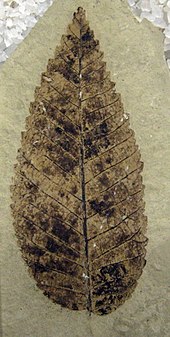 | |||
|
An elm |
 | |||
|
An elm wood species. |
 | |||
|
An elm wood species. |
 | |||
|
An elm species |
||||
|
A grape family fruit of uncertain generic placement[112] |
||||
|
incertae sedis |
"Type 1"[111] |
|
A grape family fruit of uncertain generic placement |
||
|
incertae sedis |
"Type 2"[111] |
|
A grape family fruit of uncertain generic placement |
||
|
Unidentified |
Unidentified[31] |
|
Vitoideae leaves/seeds |
| Family | Genus | species | Sites | Notes | Images |
|---|---|---|---|---|---|
|
Undescribed[36] |
|
A leaf morphotype of uncertain affiliation |
|||
|
A winged fruit of unidentified affinities |
 | |||
|
A sapindalean flower of uncertain affiliations |
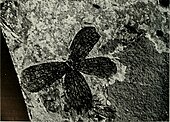 | |||
|
A semi-aquatic dicot of uncertain affinity. |
||||
|
A fruit of uncertain affiliation |
||||
|
A flower of uncertain affliation |
||||
|
A samara of uncertain affinities. |
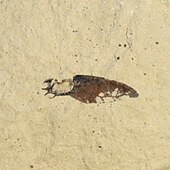 | |||
|
An incertae sedis angiosperm |
 |
Fungi
| Order | Genus | species | Sites | Notes | Images |
|---|---|---|---|---|---|
|
An ascomycetan fugus on the host palm Uhlia allenbyensis |
||||
|
An ascomycetan fugus |
||||
|
An ascomycotan fungus |
Taxa of uncertain modern identification
A number of taxa identified or described by Penhallow (1902), Penhallow (1906) and Berry (1926) have not received much or any modern attention, resulting in uncertainty of taxon affiliation, identification, or synonymy. Many late 1800's to early 1900's identifications of Okanagan highlands fossils were made based on geologic age assumptions ranging between the Miocene to Pliocene, and often specimens were grouped into species bins for taxa first described from Europe.
| Species | Reporting Author | Sites | Notes | Images |
|---|---|---|---|---|
|
Berry, 1926 |
|
A maple. |
||
|
Dawson, 1875 |
|
A maple. |
||
|
Acer negundifolium (Dawson) LaMotte (1952)[88][49] |
Dawson, 1891 |
|
Leaf fragments of a "problematic nature" |
|
|
Penhallow, 1908 |
|
A single incomplete leaf. |
||
|
Ailanthophyllum incertum Dawson[88] |
Dawson, 1890 |
|
A plant of uncertain affinity. |
|
|
Alnites curta Dawson[52][88] |
Dawson, 1890 (sp nov) |
|
Numerous betulaceous leaves and cones |
|
|
Alnus alaskana Newberry[88] |
Penhallow, 1908 |
|
Fragmentary leaves |
|
|
Alnus carpinoides Lesquereux[88] |
Penhallow, 1908 |
|
Fragmentary leaves |
|
|
Alnus serrulata fossilis Newberry[88] |
Penhallow, 1908 |
|
Fragmentary leaves |
|
|
Amygdalus gracilus Lesquereux[88] |
Penhallow, 1908 |
|
Two leaves |
|
|
Andromeda delicatula Lesquereux[88] |
Penhallow, 1908 |
|
Two Ericaceae? leaves |
|
|
Aralia acerifolia Lesquereux[88] |
Penhallow, 1908 |
|
Fragmentary leaves. |
|
|
Aralia notata Lesquereux[52][88] |
Penhallow, 1902 |
|
Fragmentary leaves. |
|
|
Betula angustifolia Newberry[88] |
Penhallow, 1908 |
|
Leaves. |
|
|
Betula heterodonta Newberry[88] |
Penhallow, 1908 |
|
Leaves and one possible cone. |
|
|
Penhallow, 1908 |
|
Fragmetary leaves with cones. |
||
|
Dawson, 1874 |
|
Single leaf. |
||
|
Betula stevensoni Lesquereux[52] |
Penhallow, 1902 |
|
Fragmentary leaves |
|
|
Carpinus grandis Unger ex Heer |
Dawson, 1890 |
|
||
|
Penhallow, 1902 |
|
Fragmentary leaves. |
||
|
†Cornus suborbifera Lesquereux? |
Penhallow, 1908 |
|
A dogwood |
|
|
Penhallow, 1907 |
|
A fossil cupressaceous? wood |
||
|
Penhallow, 1907 |
|
A monocot of uncertain affinity |
||
|
Berry, 1926 |
|
A legume like leaf morphospecies |
||
|
Liriodendron sp.[24] |
Berry, 1926 |
|
Tentative identification based on 2 partial specimens |
|
|
Musophyllum complicatum Lesquereux[24] |
Berry, 1926 |
|
A monocot morphogenus |
|
|
Dawson, 1890 (sp nov) |
|
moved to Nelumbo pygmaea (Dawson) Knowlton (1919) |
||
|
†Phragmites alaskana Heer[24] |
Berry, 1926 |
|
A grass/sedge leaf morphogenus |
|
|
Penhallow, 1902 |
|
moved to Fagopsis longifolia by Hollick (1909), possible F. undulata. |
||
|
Berry, 1926 |
|
A grass/sedge leaf morphogenus |
||
|
Dawson, 1890 |
|
Type Locality Fort union Formation |
||
|
†Pterospermites alaskana Knowlton[24] |
Berry, 1926 |
|
Type locality Keni Formation |
|
|
†Quercus groenlandica Heer[24] |
Berry, 1926 |
|
Type locality Greenland |
|
|
†Viburnum antiquum (Newberry) Hollick[24] |
Berry, 1926 |
|
A caprifoliaceous leaf morphotype |
References
- ^ a b West, C.; Greenwood, D.; Reichgelt, T.; Lowe, A.; Vachon, J.; Basinger, J. (2020). "Paleobotanical proxies for early Eocene climates and ecosystems in northern North America from middle to high latitudes". Climate of the Past. 16 (4): 1387–1410. Bibcode:2020CliPa..16.1387W. doi:10.5194/cp-16-1387-2020. S2CID 236890548.
{{cite journal}}: CS1 maint: unflagged free DOI (link) - ^ a b c DeVore, M.; Pigg, K. (2016). "Biotic processes in the Okanagan Highlands floras: Possible evidence of hybridization in plants adapting to a temperate forest". Canadian Journal of Earth Sciences. 53 (6): 622–629. Bibcode:2016CaJES..53..622D. doi:10.1139/cjes-2015-0190. hdl:1807/71962.
- ^ DeVore, M.L.; Pigg, K.B.; Wehr, W.C. (2005). "Systematics and phytogeography of selected Eocene Okanagan Highlands plants". Canadian Journal of Earth Sciences. 42 (2): 205–214. Bibcode:2005CaJES..42..205D. doi:10.1139/e04-072.
- ^ a b c d e f g h i j k l m n o p q Wehr, W. C.; Hopkins, D. Q. (1994). "The Eocene orchards and gardens of Republic, Washington". Washington Geology. 22 (3): 27–34.
- ^ a b c d e f DeVore, M. L.; Pigg, K. B. (2007). "A brief review of the fossil history of the family Rosaceae with a focus on the Eocene Okanogan Highlands of eastern Washington State, USA, and British Columbia, Canada". Plant Systematics and Evolution. 266 (1–2): 45–57. doi:10.1007/s00606-007-0540-3. S2CID 10169419.
- ^ a b c Moss, P. T.; Greenwood, D. R.; Archibald, S. B. (2005). "Regional and local vegetation community dynamics of the Eocene Okanagan Highlands (British Columbia – Washington State) from palynology". Canadian Journal of Earth Sciences. 42 (2): 187–204. Bibcode:2005CaJES..42..187M. doi:10.1139/E04-095.
- ^ a b Archibald, S. B.; Cannings, R. A. (2022). "The first Odonata from the early Eocene Allenby Formation of the Okanagan Highlands, British Columbia, Canada (Anisoptera, Aeshnidae and cf. Cephalozygoptera, Dysagrionidae)". The Canadian Entomologist. 154 (1): e29. doi:10.4039/tce.2022.16. S2CID 250035713.
- ^ Höy, T.; Friedman, R.; Gabites, J. Paleogene Penticton Group, Boundary area, Southern British Columbia (Parts of NTS 082E): Geochronology and Implications for Precious Metal Mineralization (PDF) (Report). Geoscience BC Summary of Activities 2020: Minerals, Geoscience BC, Report 2021-01. Geoscience BC. pp. 55–66.
- ^ Pigg, K. B.; DeVore, M. L. (2016). "A review of the plants of the Princeton chert (Eocene, British Columbia, Canada)". Botany. 94 (9): 661–681. doi:10.1139/cjb-2016-0079. hdl:1807/73571.
- ^ Archibald, S. B.; Rasnitsyn, A. P.; Brothers, D. J.; Mathewes, R. W. (2018). "Modernisation of the Hymenoptera: ants, bees, wasps, and sawflies of the early Eocene Okanagan Highlands of western North America". The Canadian Entomologist. 150 (2): 205–257. doi:10.4039/tce.2017.59. ISSN 0008-347X. S2CID 90017208.
- ^ a b Siver, P. A.; Wolfe, A. P.; Edlund, M. B.; Sibley, J.; Hausman, J.; Torres, P.; Lott, A. M. (2019). "Aulacoseira giraffensis (Bacillariophyceae), a new diatom species forming massive populations in an Eocene lake". Plant Ecology and Evolution. 152 (2): 358–367. doi:10.5091/plecevo.2019.1586. S2CID 199531867.
- ^ a b Siver, P. A.; Skogstad, A.; Nemcova, Y. (2019). "Endemism, palaeoendemism and migration: the case for the 'European endemic', Mallomonas intermedia". European Journal of Phycology. 54 (2): 222–234. doi:10.1080/09670262.2018.1544377. S2CID 85555530.
- ^ Wolfe, A.; Edlund, M. (2005). "Taxonomy, phylogeny, and paleoecology of Eoseira wilsonii gen. et sp. nov., a Middle Eocene diatom (Bacillariophyceae: Aulacoseiraceae) from lake sediments at Horsefly, British Columbia, Canada". Canadian Journal of Earth Sciences. 42 (2): 243–257. Bibcode:2005CaJES..42..243W. doi:10.1139/e04-051.
- ^ a b Kuc, M. (1972). "Muscites eocenicus sp. nov.—a fossil moss from the Allenby Formation (middle Eocene), British Columbia". Canadian Journal of Earth Sciences. 9 (5): 600–602. Bibcode:1972CaJES...9..600K. doi:10.1139/e72-049.
- ^ a b c d e f Kuc, M. (1974). "Fossil mosses from the bisaccate zone of the mid-Eocene Allenby Formation, British Columbia". Canadian Journal of Earth Sciences. 11 (3): 409–421. Bibcode:1974CaJES..11..409K. doi:10.1139/e74-037.
- ^ a b c d Miller, N. G. (1980). "Fossil mosses of North America and their significance". The Mosses of North America. pp. 9–36.
- ^ a b Janssens, J.; Horton, D.G.; Basinger, J. (1979). "Aulacomnium heterostichoides sp. nov., an Eocene moss from south central British Columbia". Canadian Journal of Botany. 57 (20): 2150–2161. doi:10.1139/b79-268.
- ^ a b c d e f g h i j Dillhoff, R.M.; Dillhoff, T.A.; Greenwood, D.R.; DeVore, M.L.; Pigg, K.B. (2013). "The Eocene Thomas Ranch flora, Allenby Formation, Princeton, British Columbia, Canada". Botany. 91 (8): 514–529. doi:10.1139/cjb-2012-0313.
- ^ a b Wing, S.; DiMichele, W. (1996). "The Republic Highlands". Washington Geology. 24 (2): 40.
- ^ a b c d e f g h i j Wehr, W. "Middle Eocene insects and plants of the Okanogan Highlands". In Martin, J. (ed.). Contributions to the Paleontology and Geology of the West Coast. Seattle, Washington: University of Washington Press. pp. 99–109.
- ^ Karafit, S. J.; Rothwell, G. W.; Stockey, R. A.; Nishida, H. (2006). "Evidence for sympodial vascular architecture in a filicalean fern rhizome: Dickwhitea allenbyensis gen. et sp. nov.(Athyriaceae)". International Journal of Plant Sciences. 167 (3): 721–727. doi:10.1086/501036. S2CID 85348245.
- ^ Stockey, R. A.; Nishida, H.; Rothwell, G. W. (1999). "Permineralized ferns from the middle Eocene Princeton chert. I. Makotopteris princetonensis gen. et sp. nov.(Athyriaceae)". International Journal of Plant Sciences. 160 (5): 1047–1055. doi:10.1086/314191. PMID 10506480. S2CID 33465214.
- ^ a b c d e f g h i j k l m n o p q r s t u v w x y z aa ab ac ad ae af ag ah ai aj ak al am an ao Greenwood, D.R.; Pigg, K.B.; Basinger, J.F.; DeVore, M.L. (2016). "A review of paleobotanical studies of the Early Eocene Okanagan (Okanogan) Highlands floras of British Columbia, Canada, and Washington, U.S.A." Canadian Journal of Earth Sciences. 53 (6): 548–564. Bibcode:2016CaJES..53..548G. doi:10.1139/cjes-2015-0177.
- ^ a b c d e f g h i j k l m n o p q r s t u v w x y z aa ab ac ad ae af ag ah Berry, E. (1926). Tertiary floras from British Columbia (PDF) (Report). Geological series; Contributions to Canadian Paleontology. Ottawa, Canada: Geological Survey of Canada. pp. 91–116.
- ^ Smith, S. Y.; Stockey, R. A.; Nishida, H.; Rothwell, G. W. (2006). "Trawetsia princetonensis gen. et sp. nov.(Blechnaceae): a permineralized fern from the Middle Eocene Princeton Chert". International Journal of Plant Sciences. 167 (3): 711–719. doi:10.1086/501034. S2CID 85160532.
- ^ a b Pigg, K. B.; DeVore, M. L.; Greenwood, D. R.; Sundue, M. A.; Schwartsburd, P.; Basinger, J. F. (2021). "Fossil Dennstaedtiaceae and Hymenophyllaceae from the Early Eocene of the Pacific Northwest". International Journal of Plant Sciences. 182 (9): 793–807. doi:10.1086/715633. S2CID 239036762.
- ^ Cevallos-Ferriz, S. R.; Stockey, R. A.; Pigg, K. B. (1991). "The Princeton chert: evidence for in situ aquatic plants". Review of Palaeobotany and Palynology. 70 (1–2): 173–185. doi:10.1016/0034-6667(91)90085-H.
- ^ Dawson, J. W. (1879). "Appendix B. List of tertiary plants in the southern part of British Columbia, with the description of a new species of Equisetum". Geological Survey of Canada, Report of Progress for. Vol. 1877–1878. Montreal, Quebec: Dawson Brothers. p. 187.
- ^ a b Dawson, J. W. (1890). On fossil plants from the Similkameen Valley and other places in the southern interior of British Columbia. CIHM/ICMH Microfiche no. 14891. Royal Society of Canada. ISBN 9780665148910.
- ^ Joseph, N. L. (1988). "Important Eocene Flora and Fauna Unearthed at Republic, Washington". Rocks & Minerals. 63 (2): 146–151. doi:10.1080/00357529.1988.11761830.
- ^ a b c d e f g h i j k l m n o p q r s t u v w x y z aa ab ac ad ae af ag ah ai aj ak al am an ao ap aq ar as at au av aw ax ay az ba bb bc bd be bf bg bh bi bj bk bl bm bn bo Greenwood, D.; Archibald, S.; Mathewes, R.; Moss, P. (2005). "Fossil biotas from the Okanagan Highlands, southern British Columbia and northeastern Washington State: climates and ecosystems across an Eocene landscape". Canadian Journal of Earth Sciences. 42 (2): 167–185. Bibcode:2005CaJES..42..167G. doi:10.1139/e04-100.
- ^ Collinson, M. E. (2001). "Cainozoic ferns and their distribution". Brittonia. 53 (2): 173–235. doi:10.1007/BF02812700. S2CID 19984401.
- ^ Arnold, C. A. (1955). "A Tertiary Azolla from British Columbia" (PDF). Contributions from the Museum of Paleontology, University of Michigan. 12 (4): 37–45.
- ^ a b c d e f g h i j k l m n o p Mathewes, R. W.; Greenwood, D. R.; Archibald, S. B. (2016). "Paleoenvironment of the Quilchena flora, British Columbia, during the Early Eocene Climatic Optimum" (PDF). Canadian Journal of Earth Sciences. 53 (6): 574–590. Bibcode:2016CaJES..53..574M. doi:10.1139/cjes-2015-0163. hdl:1807/71979.
- ^ Hopkins, D.; Johnson, K. (1997). "First Record of cycad leaves from the Eocene Republic flora" (PDF). Washington Geology. 25 (4): 37. Retrieved 29 September 2021.
- ^ a b c d e f g h i j k l m n o p q r s t u v w x y z aa ab ac ad ae af ag ah ai aj ak al am an ao ap aq ar as at au av aw ax ay az ba bb bc bd be bf bg bh bi bj bk bl bm bn bo bp bq br Dillhoff, R.M.; Leopold, E.B.; Manchester, S.R. (2005). "The McAbee flora of British Columbia and its relations to the Early-Middle Eocene Okanagan Highlands flora of the Pacific Northwest" (PDF). Canadian Journal of Earth Sciences. 42 (2): 151–166. Bibcode:2005CaJES..42..151D. doi:10.1139/e04-084.
- ^ a b Mustoe, G.E. (2002). "Eocene Ginkgo leaf fossils from the Pacific Northwest". Canadian Journal of Botany. 80 (10): 1078–1087. doi:10.1139/b02-097.
- ^ a b c d e f Smith, R.Y.; Basinger, J.F.; Greenwood, D.R. (2012). "Early Eocene plant diversity and dynamics in the Falkland flora, Okanagan Highlands, British Columbia, Canada". Palaeobiodiversity and Palaeoenvironments. 92 (3): 309–328. doi:10.1007/s12549-011-0061-5. S2CID 129448108.
- ^ a b c d e f g h i j Arnold, C. A. (1955). "Tertiary conifers from the Princeton coal field of British Columbia" (PDF). University of Michigan: Contributions from the Museum of Paleontology. 12: 245–258.
- ^ a b c d e f g h i j Schorn, H. E.; Wehr, W. C. (1996). "The conifer flora from the Eocene uplands at Republic, Washington". Washington Geology. 24 (2): 22–24.
- ^ Terry, R.; Pyne, M.; Bartel, J.; Adams, R. (2016). "A molecular biogeography of the New World cypresses (Callitropsis, Hesperocyparis; Cupressaceae)". Plant Systematics and Evolution. 302 (7): 921–942. doi:10.1007/s00606-016-1308-4. JSTOR 44853291. S2CID 4236846.
- ^ Basinger, J. F. (1981). "The vegetative body of Metasequoia milleri from the Middle Eocene of southern British Columbia". Canadian Journal of Botany. 59 (12): 2379–2410. doi:10.1139/b81-291.
- ^ a b c d e f g h i Penhallow, D. P. (1907). "A report on fossil plants from the International Boundary Survey for 1903–1905, collected by Dr. R A Daly.". Proceedings and Transactions of the Royal Society of Canada. 3. Vol. 1 (sect 4). Royal Society of Canada. pp. 287–351.
- ^ a b Chaney, R.W. (1951). "A revision of fossil Sequoia and Taxodium in western North America based on the recent discovery of Metasequoia". Transactions of the American Philosophical Society. 40 (3): 231.
- ^ a b c d e f g h i j k l m n o p q r s t u v w x y Wolfe, J.A.; Wehr, W.C. (1987). Middle Eocene dicotyledonous plants from Republic, northeastern Washington (Report). Bulletin. Vol. 1597. United States Geological Survey. pp. 1–25. doi:10.3133/b1597.
- ^ LePage, B. A. (2007). "The taxonomy and biogeographic history of Glyptostrobus Endlicher (Cupressaceae)". Bulletin of the Peabody Museum of Natural History. 48 (2): 359–426. doi:10.3374/0079-032x(2007)48[359:ttabho]2.0.co;2. S2CID 128968431.
- ^ a b c d e f g Berry, E.W. (1929). "A revision of the flora of the Latah Formation". (Report). Professional Paper. United States Geological Survey. pp. 225–265. doi:10.3133/pp154h. 154-H.
{{cite report}}: Missing or empty|title=(help) - ^ Schorn, Howard; Wehr, Wesley (1986). "Abies milleri, sp. nov., from the Middle Eocene Klondike Mountain Formation, Republic, Ferry County, Washington". Burke Museum Contributions in Anthropology and Natural History (1): 1–7.
- ^ a b c d e f g LaMotte, R.S. (1952). Catalogue of the Cenozoic plants of North America through 1950. Geological Society of America Memoirs. Vol. 51. Geological Society of America. doi:10.1130/MEM51.
- ^ a b LePage, B. A.; Basinger, J. F. (1995). "Evolutionary history of the genus Pseudolarix Gordon (Pinaceae)". International Journal of Plant Sciences. 156 (6): 910–950. doi:10.1086/297313. S2CID 84724593.
- ^ a b Gooch, N. L. (1992). "Two new species of Pseudolarix Gordon (Pinaceae) from the middle Eocene of the Pacific Northwest". PaleoBios. 14: 13–19.
- ^ a b c d e f g h Penhallow, D. P. (1902). Notes on Cretaceous and Tertiary plants of Canada (2d ser., v. 8, sec. 4 ed.). Ottawa, Canada: Transactions of the Royal Society of Canada. 1902-03. pp. 31–91.
- ^ a b c Stockey, R. A. (1984). "Middle Eocene Pinus remains from British Columbia". Botanical Gazette. 145 (2): 262–274. doi:10.1086/337455. S2CID 85063424.
- ^ a b Miller Jr, C. N. (1973). "Silicified cones and vegetative remains of Pinus from Eocene of British Columbia". Contributions from the Museum of Paleontology, University of Michigan. 24: 101–118.
- ^ a b Klymiuk, A. A.; Stockey, R. A.; Rothwell, G. W. (2011). "The first organismal concept for an extinct species of Pinaceae: Pinus arnoldii Miller". International Journal of Plant Sciences. 172 (2): 294–313. doi:10.1086/657649. S2CID 84137991.
- ^ Stockey, R.S. (1983). "Pinus driftwoodensis sp.n. from the early Tertiary of British Columbia". Botanical Gazette. 144 (1): 148–156. doi:10.1086/337355. JSTOR 2474678. S2CID 84907438.
- ^ LaMotte, R.S. (1944). "Supplement to catalogue of Mesozoic and Cenozoic plants of North America, 1919–37". United States Geological Survey Bulletin. 924: 307.
- ^ a b c DeVore, ML; Taylor, W; Pigg, KB (2015). "Nuphar carlquistii sp. nov. (Nymphaeaceae): A Water Lily from the Latest Early Eocene, Republic, Washington". International Journal of Plant Sciences. 176 (4): 365–377. doi:10.1086/680482. S2CID 84149074.
- ^ a b Cevallos-Ferriz, S. R.; Stockey, R. A. (1989). "Permineralized fruits and seeds from the Princeton chert (Middle Eocene) of British Columbia: Nymphaeaceae". Botanical Gazette. 150 (2): 207–217. doi:10.1086/337765. S2CID 86651676.
- ^ a b c d Wehr, W.C. (1995). "Paleobotanical Significance of Eocene Flowers, Fruits, and Seeds from Republic, Washington". Washington Geology. 24 (2): 25–2.
- ^ Cevallos-Ferriz, S. R.; Stockey, R. A. (1990). "Vegetative remains of the Magnoliaceae from the Princeton chert (middle Eocene) of British Columbia". Canadian Journal of Botany. 68 (6): 1327–1339. doi:10.1139/b90-169.
- ^ Smith, S. Y.; Stockey, R. A. (2007). "Establishing a fossil record for the perianthless Piperales: Saururus tuckerae sp. nov.(Saururaceae) from the Middle Eocene Princeton Chert". American Journal of Botany. 94 (10): 1642–1657. doi:10.3732/ajb.94.10.1642. PMID 21636361.
- ^ Manchester, S.; Pigg, K. (2008). "The Eocene mystery flower of McAbee, British Columbia". Botany. 86 (9): 1034–1038. doi:10.1139/B08-044.
- ^ Stockey, R. A. (1987). "A permineralized flower from the Middle Eocene of British Columbia". American Journal of Botany. 74 (12): 1878–1887. doi:10.1002/j.1537-2197.1987.tb08790.x.
- ^ Stockey, R. A.; Pigg, K. B. (1991). "Flowers and fruits of Princetonia allenbyensis (Magnoliopsida; family indet.) from the Middle Eocene Princeton chert of British Columbia". Review of Palaeobotany and Palynology. 70 (1–2): 163–172. doi:10.1016/0034-6667(91)90084-G.
- ^ Erwin, D. M.; Stockey, R. A. (1991). "Silicified monocotyledons from the Middle Eocene Princeton chert (Allenby Formation) of British Columbia, Canada". Review of Palaeobotany and Palynology. 70 ((1-2)): 147–162. doi:10.1016/0034-6667(91)90083-F.
- ^ Pigg, K. B.; Bryan, F. A.; DeVore, M. L. (2018). "Paleoallium billgenseli gen. et sp. nov.: fossil monocot remains from the latest Early Eocene Republic Flora, northeastern Washington State, USA". International Journal of Plant Sciences. 179 (6): 477–486. doi:10.1086/697898. S2CID 91055581.
- ^ Grímsson, F.; Zetter, R.; Halbritter, H.; Grimm, G. W. (2014). "Aponogeton pollen from the Cretaceous and Paleogene of North America and West Greenland: Implications for the origin and palaeobiogeography of the genus". Review of Palaeobotany and Palynology. 200 (100): 161–187. doi:10.1016/j.revpalbo.2013.09.005. PMC 4047627. PMID 24926107.
- ^ Cevallos-Ferriz, S. R.; Stockey, R. A. (1988). "Permineralized fruits and seeds from the Princeton chert (Middle Eocene) of British Columbia: Araceae". American Journal of Botany. 75 (8): 1099–1113. doi:10.1002/j.1537-2197.1988.tb08822.x.
- ^ Bogner, J.; Johnson, K. R.; Kvacek, Z.; Upchurch, G. R. (2007). "New fossil leaves of Araceae from the Late Cretaceous and Paleogene of western North America" (PDF). Zitteliana. A (47): 133–147. ISSN 1612-412X.
- ^ Erwin, D.M.; Stockey, R.A. (1994). "Permineralized monocotyledons from the middle Eocene Princeton chert (Allenby Formation) of British Columbia: Arecaceae". Palaeontographica Abteilung B. 234: 19–40.
- ^ Hesse, M.; Zetter, R. (2005). "Ultrastructure and diversity of recent and fossil zona-aperturate pollen grains". Plant Systematics and Evolution. 255 (3): 145–176. doi:10.1007/s00606-005-0358-9. S2CID 1964359.
- ^ Erwin, D. M.; Stockey, R. A. (1992). "Vegetative body of a permineralized monocotyledon from the Middle Eocene Princeton chert of British Columbia". Courier Forschungsinstitut Senckenberg. 147: 309–327.
- ^ Erwin, D. M.; Stockey, R. A. (1991). "Soleredera rhizomorpha gen. et sp. nov., a permineralized monocotyledon from the Middle Eocene Princeton chert of British Columbia, Canada". Botanical Gazette. 152 (2): 231–247. doi:10.1086/337885. S2CID 85180086.
- ^ a b Huegele, I. B.; Manchester, S. R. (2022). "Newly Recognized Reproductive Structures Linked with Langeria from the Eocene of Washington, USA, and their Affinities with Platanaceae". International Journal of Plant Sciences. In press.
- ^ a b c d e f g h i Wehr, W.C. (1995). "Early Tertiary flowers, fruits and seeds of Washington State and adjacent areas". Washington Geology. 23 (3): 3–16.
- ^ a b c d Pigg, K.; Wehr, W.C. (2002). "Early Tertiary flowers, fruits and seeds of Washington State and adjacent areas Part-III". Washington Geology. 30 (3–4): 3–16.
- ^ a b c d Manchester, S. R.; Kvaček, Z.; Judd, W. S. (2020). "Morphology, anatomy, phylogenetics and distribution of fossil and extant Trochodendraceae in the Northern Hemisphere". Botanical Journal of the Linnean Society. 195 (3): 467–484. doi:10.1093/botlinnean/boaa046.
- ^ a b c Manchester, S.; Pigg, K. B.; Kvaček, Z; DeVore, M. L.; Dillhoff, R. M. (2018). "Newly recognized diversity in Trochodendraceae from the Eocene of western North America". International Journal of Plant Sciences. 179 (8): 663–676. doi:10.1086/699282. S2CID 92201595.
- ^ Pigg, K.B.; Dillhoff, R.M.; DeVore, M.L.; Wehr, W.C. (2007). "New diversity among the Trochodendraceae from the Early/Middle Eocene Okanogan Highlands of British Columbia, Canada, and Northeastern Washington State, United States". International Journal of Plant Sciences. 168 (4): 521–532. doi:10.1086/512104. S2CID 86524324.
- ^ Pigg, K.B.; Wehr, W.C.; Ickert-Bond, S.M. (2001). "Trochodendron and Nordenskioldia (Trochodendraceae) from the Middle Eocene of Washington State, U.S.A.". International Journal of Plant Sciences. 162 (5): 1187–1198. doi:10.1086/321927. S2CID 45399415.
- ^ a b Call, V.B.; Dilcher, D.L. (1997). "The fossil record of Eucommia (Eucommiaceae) in North America" (PDF). American Journal of Botany. 84 (6): 798–814. doi:10.2307/2445816. JSTOR 2445816. PMID 21708632. S2CID 20464075.
- ^ Stockey, R. A.; LePage, B. A.; Pigg, K. B. (1998). "Permineralized fruits of Diplopanax (Cornaceae, Mastixioideae) from the middle Eocene Princeton chert of British Columbia". Review of Palaeobotany and Palynology. 103 (3–4): 223–234. doi:10.1016/S0034-6667(98)00038-4.
- ^ a b Mathewes, R.; Archibald, S. B.; Lundgren, A. (2021). "Tips and identification of early Eocene Fraxinus L. samaras from the Quilchena locality, Okanagan Highlands, British Columbia, Canada". Review of Palaeobotany and Palynology. 104480.
- ^ a b c d Flynn, S.; DeVore, M. L.; Pigg, K. B. (2019). "Morphological Features of Sumac Leaves (Rhus, Anacardiaceae), from the Latest Early Eocene Flora of Republic, Washington". International Journal of Plant Sciences. 180 (6): 464–478. doi:10.1086/703526. S2CID 198244783.
- ^ Crane, P.; Stockey, R. (1987). "Betula leaves and reproductive structures from the Middle Eocene of British Columbia, Canada". Canadian Journal of Botany. 65 (12): 2490–2500. doi:10.1139/b87-338.
- ^ a b c d e f Pigg, K.B.; Manchester S.R.; Wehr W.C. (2003). "Corylus, Carpinus, and Palaeocarpinus (Betulaceae) from the Middle Eocene Klondike Mountain and Allenby Formations of Northwestern North America". International Journal of Plant Sciences. 164 (5): 807–822. doi:10.1086/376816. S2CID 19802370.
- ^ a b c d e f g h i j k l m n o p q r Penhallow, D. P. (1908). Report on Tertiary plants of British Columbia collected by Lawrence M. Lambe in 1906 together with a discussion of previously recorded tertiary floras (Report). Geological series; Contributions to Canadian Paleontology. Ottawa, Canada: Geological Survey of Canada. pp. 1–167.
- ^ Brown, R. (1939). "Fossil Leaves, Fruits, and Seeds of Cercidiphyllum". Journal of Paleontology. 13 (5): 485–499. JSTOR 1298516.
- ^ Manchester, S. R.; Dillhoff, R. M. (2004). "Fagus (Fagaceae) fruits, foliage, and pollen from the Middle Eocene of Pacific Northwestern North America". Canadian Journal of Botany. 82 (10): 1509–1517. doi:10.1139/b04-112.
- ^ Cevallos-Ferriz, S. R. S. (1995). "Fruits of Ribes from the Princeton chert, British Columbia, Canada". American Journal of Botany. 82 (6).
- ^ a b Radtke, M.G.; Pigg, K.B.; Wehr, W.C. (2005). "Fossil Corylopsis and Fothergilla Leaves (Hamamelidaceae) from the Lower Eocene Flora of Republic, Washington, U.S.A., and Their Evolutionary and Biogeographic Significance". International Journal of Plant Sciences. 166 (2): 347–356. doi:10.1086/427483. S2CID 20215269.
- ^ Manchester, S. R. (1991). "Cruciptera, a new Juglandaceous winged fruit from the Eocene and Oligocene of western North America". Systematic Botany. 16 (4): 715–725. doi:10.2307/2418873. JSTOR 2418873.
- ^ Cevallos-Ferriz, S. R.; Stockey, R. A. (1988). "Permineralized fruits and seeds from the Princeton chert (Middle Eocene) of British Columbia: Lythraceae". Canadian Journal of Botany. 66 (2): 303–312. doi:10.1139/b88-050.
- ^ Lowe, A. J.; Greenwood, D. R.; West, C. K.; Galloway, J. M.; Sudermann, M.; Reichgelt, T. (2018). "Plant community ecology and climate on an upland volcanic landscape during the Early Eocene Climatic Optimum: McAbee Fossil Beds, British Columbia, Canada". Palaeogeography, Palaeoclimatology, Palaeoecology. 511: 433–448. Bibcode:2018PPP...511..433L. doi:10.1016/j.palaeo.2018.09.010. S2CID 134962126.
- ^ Smith, R. Y.; Basinger, J. F.; Greenwood, D. R. (2009). "Depositional setting, fossil flora, and paleoenvironment of the Early Eocene Falkland site, Okanagan Highlands, British Columbia". Canadian Journal of Earth Sciences. 46 (11): 811–822. Bibcode:2009CaJES..46..811S. doi:10.1139/E09-053.
- ^ Pigg, K. B.; Stockey, R. A.; Maxwell, S. L. (1993). ""Paleomyrtinaea", a new genus of permineralized myrtaceous fruits and seeds from the Eocene of British Columbia and Paleocene of North Dakota". Canadian Journal of Botany. 71 (1): 1–9. doi:10.1139/b93-001.
- ^ DeVore, M.L.; Moore, S.M.; Pigg, K.B.; Wehr, W.C. (2004). "Fossil Neviusia leaves (Rosaceae: Kerrieae) from the Lower Middle Eocene of Southern British Columbia". Rhodora. 12 (927): 197–209. JSTOR 23314752.
- ^ a b Benedict, JC; DeVore, ML; Pigg, KB (2011). "Prunus and Oemleria (Rosaceae) Flowers from the Late Early Eocene Republic Flora of Northeastern Washington State, U.S.A.". International Journal of Plant Sciences. 172 (7): 948–958. doi:10.1086/660880. S2CID 39391439.
- ^ Basinger, JF (1976). "Paleorosa similkameenensis, gen. et sp. nov., permineralized flowers (Rosaceae) from the Eocene of British Columbia". Canadian Journal of Botany. 54 (20): 2293–2305. doi:10.1139/b76-246.
- ^ a b c d Cevallos-Ferriz, S. R.; Stockey, R. A. (1990). "Vegetative remains of the Rosaceae from the Princeton chert (Middle Eocene) of British Columbia". IAWA Journal. 11 (3): 261–280. doi:10.1163/22941932-90001183. S2CID 85023353.
- ^ Wolfe, J.A.; Wehr, W.C. (1988). "Rosaceous Chamaebatiaria-like foliage from the Paleogene of western North America". Aliso. 12 (1): 177–200. doi:10.5642/aliso.19881201.14.
- ^ Oh, S.-H.; Potter, D. (2005). "Molecular phylogenetic systematics and biogeography of tribe Neillieae (Rosaceae) using DNA sequences of cpDNA, rDNA, and LEAFY". American Journal of Botany. 92 (1): 179–192. doi:10.3732/ajb.92.1.179. PMID 21652396.
- ^ a b c d e f g h i j k l Wolfe, J.A.; Tanai, T. (1987). "Systematics, Phylogeny, and Distribution of Acer (maples) in the Cenozoic of Western North America". Journal of the Faculty of Science, Hokkaido University. Series 4, Geology and Mineralogy. 22 (1): 1–246.
- ^ Harris, A. J.; Papes, M.; Gao, Y. D.; Watson, L. (2014). "Estimating paleoenvironments using ecological niche models of nearest living relatives: A case study of Eocene Aesculus L.". Journal of Systematics and Evolution. 52 (1): 16–34. doi:10.1111/jse.12053. S2CID 83926177.
- ^ McClain, A. M.; Manchester, S. R. (2001). "Dipteronia (Sapindaceae) from the Tertiary of North America and implications for the phytogeographic history of the Aceroideae". American Journal of Botany. 88 (7): 1316–25. doi:10.2307/3558343. JSTOR 3558343. PMID 11454632.
- ^ a b Wang, Q.; Manchester, S. R.; Gregor, H. J.; Shen, S.; Li, Z. Y. (2013). "Fruits of Koelreuteria (Sapindaceae) from the Cenozoic throughout the northern hemisphere: their ecological, evolutionary, and biogeographic implications". American Journal of Botany. 100 (2): 422–449. doi:10.3732/ajb.1200415. PMID 23360930.
- ^ Erwin, D. M.; Stockey, R. A. (1990). "Sapindaceous flowers from the Middle Eocene Princeton chert (Allenby Formation) of British Columbia, Canada". Canadian Journal of Botany. 68 (9): 2025–2034. doi:10.1139/b90-265.
- ^ Edwards, W. N. (1931). Jongmans, W. (ed.). Fossilium Catalogus. II. Plantae. Pars 17. Dicotyledones (Ligna). Berlin.
{{cite book}}: CS1 maint: location missing publisher (link) - ^ a b Denk, T.; Dillhoff, R.M. (2005). "Ulmus leaves and fruits from the Early-Middle Eocene of northwestern North America: systematics and implications for character evolution within Ulmaceae" (PDF). Canadian Journal of Botany. 83 (12): 1663–1681. doi:10.1139/b05-122.
- ^ a b c Cevallos-Ferriz, S. R.; Stockey, R. A. (1990). "Permineralized fruits and seeds from the Princeton chert (Middle Eocene) of British Columbia: Vitaceae". Canadian Journal of Botany. 68 (2): 288–295. doi:10.1139/b90-039.
- ^ a b Chen, I.; Manchester, S. R. (2007). "Seed morphology of modern and fossil Ampelocissus (Vitaceae) and implications for phytogeography". American Journal of Botany. 94 (9): 1534–1553. doi:10.3732/ajb.94.9.1534. PMID 21636520.
- ^ Wang, Y.; Manchester, S. R. (2000). "Chaneya, a new genus of winged fruit from the Tertiary of North America and eastern Asia". International Journal of Plant Sciences. 161 (1): 167–178. doi:10.1086/314227. PMID 10648207. S2CID 45052368.
- ^ Robison, C. R.; Person, C. P. (1973). "A silicified semiaquatic dicotyledon from the Eocene Allenby Formation of British Columbia". Canadian Journal of Botany. 51 (7): 1373–1377. doi:10.1139/b73-172.
- ^ Stockey, R.; Pigg, K. (1994). "Vegetative growth of Eorhiza arnoldii Robison and Person from the Middle Eocene Princeton chert locality of British Columbia". International Journal of Plant Sciences. 155 (5): 606–616. doi:10.1086/297199. S2CID 85094707.
- ^ McMurran, D. M.; Manchester, S. R. (2010). "Lagokarpos lacustris, a new winged fruit from the Paleogene of western North America". International Journal of Plant Sciences. 171 (2): 227–234. doi:10.1086/648994. S2CID 85399829.
- ^ Stockey, R. A.; Manchester, S. R. (1988). "A fossil flower with in situ Pistillipollenites from the Eocene of British Columbia". Canadian Journal of Botany. 66 (2): 313–318. doi:10.1139/b88-051.
- ^ Manchester, S.R. (1994). "Fruits and Seeds of the Middle Eocene Nut Beds Flora, Clarno Formation, Oregon". Palaeontographica Americana. 58: 30–31.
- ^ a b Currah, R.S.; Stockey, R.A.; LePage, B.A. (1998). "An Eocene tar spot on a fossil palm and its fungal hyperparasite". Mycologia. 90 (4): 667–673. doi:10.1080/00275514.1998.12026955.
- ^ Klymiuk, A. A. (2016). "Paleomycology of the Princeton Chert. III. Dictyosporic microfungi, Monodictysporites princetonensis gen. et sp. nov., associated with decayed rhizomes of an Eocene semi-aquatic fern". Mycologia. 108 (5): 882–890. doi:10.3852/15-022. PMID 27302048. S2CID 7871220.
